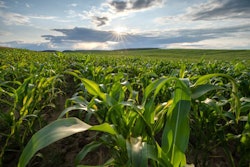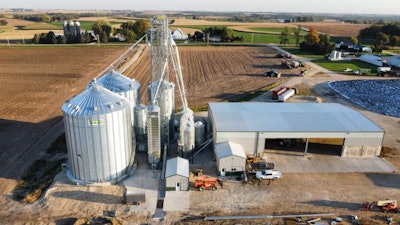
3 ways automating a feed center can reduce shrink and impact the bottom line
The utilization of automation in dairy feed centers has the potential to reduce feed shrink and decrease labor — paying for itself within a few years. With margins continuing to run thin in the dairy and feedlot industries, investing in advancements for an operation only make sense when there is a strong guarantee for return on investment.
As Jeff Salfer, University of Minnesota Extension Dairy Educator, noted, “feed costs account for nearly 40% to 50% of the total operating budget.” Feed shrink is the biggest and likely easiest way to reduce feed costs for operations.
Applying automation technology to a feed center can significantly improve the traceability of ingredients and products used at an operation and, more importantly, can help reduce feed shrink and waste significantly.
Even if 10 cents were saved per day, per cow on a 2,000-cow dairy, that would lead to a savings of $73,000 a year. Although 10 cents a day seems to be insignificant in the overall operating budget, tracking it and adding it up by cows per year shows the potential impact. Upgrading to an automated feed center could pay for itself in only a few years.
There are three ways feed automation technology can help decrease shrink.
- Increased weigh-up accuracy of high-cost ingredients
Typically, the most expensive ingredients are those with the lowest inclusion rate in rations. While many operations still use a front-end loader to mix their rations, utilizing this type of equipment on these low-inclusion rate ingredients reduces the accuracy threshold for these ingredients. The weigh-up deviation for a front loader could be as much as 10 pounds, whereas, on an automation system, there is typically less than a 1-pound weigh-up deviation. A decrease in possible deviation by 9 pounds for every ration every day starts to add up quickly. Additional infrastructure, such as an auger or feeder screw, is required to utilize automation for weighing and routing a product to the mixer, but with the luxury of controlling this system from a tablet within the front loader as other forage ingredients are brought to the mixer as well. Investing in an automation system to handle these high-cost ingredients will decrease waste and, overall, stretch the longevity of these high-cost ingredients.
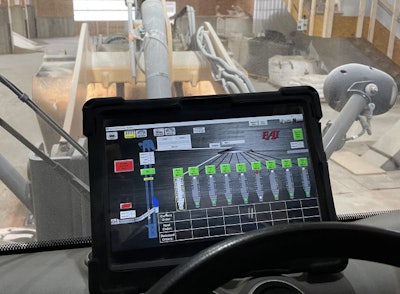 Tablets can be used in the payloader to use the automation system to batch feed while loading the bulk ingredients in with the payloader. (Courtesy Easy Automation)
Tablets can be used in the payloader to use the automation system to batch feed while loading the bulk ingredients in with the payloader. (Courtesy Easy Automation) Panoramic view of the combination feed center to include payloader ingredients and auger-measured ingredients to mix the rations. (Courtesy Easy Automation)
Panoramic view of the combination feed center to include payloader ingredients and auger-measured ingredients to mix the rations. (Courtesy Easy Automation)- Bin and flat storage combination system capability
Automation in a feed center allows for a unique and customizable storage system based on the farm’s specific needs and ingredients. While the use of flat storage and the traditional front-loader batching style has worked in the past, efficiency and cost are consistent pressures and the ability to utilize a bin and flat storage combination lies in the hands of automation. Storing the high-cost ingredients in the bins reduces waste due to external climatic factors, ultimately reducing shrink. This allows for these ingredients to be moved to the mixer through automated augers. While the augers and mixer can be hooked up to automation, moving forages and other hard-to-handle materials with the front-end loader to the mixer is still an option with an automation system. Additionally, having the ability to store grain on site allows for the ability to purchase commodities with more flexibility based on price and availability. Being able to plan and have commodities on hand can save cost, sometimes significantly. Automation has the flexibility and customization capability to create a solution for all types of facilities and feed centers.
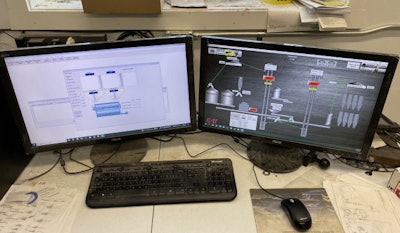 Integrating an automation system into a feed center allows for full control of automated equipment through an HMI screen in an office setting. (Courtesy Easy Automation)
Integrating an automation system into a feed center allows for full control of automated equipment through an HMI screen in an office setting. (Courtesy Easy Automation)- Ability to track and manage ingredient inventory
Nothing can be improved unless it is tracked with real data and real analytics. The opportunity presented by reducing feed shrink is too great to be based on estimates or how it has always been. Ordering on average 10% to 20% more on certain ingredients in a ration simply due to an estimated shrink is money falling through the fingers of farmers. Implementing an automation system that tracks and manages the inventory of ingredients is a starting point to reducing shrink. With nutrition closely tied to conception rates and milk production, utilizing high-cost, concentrated ingredients have become only more common. Automation technology can reduce the waste of these ingredients by eliminating human or payloader error and automatically integrating the correct amount of each into the ration. Investing in software that allows evaluation of estimated and actual feed mixed or fed can help bring forward the gaps and opportunities for improvement.
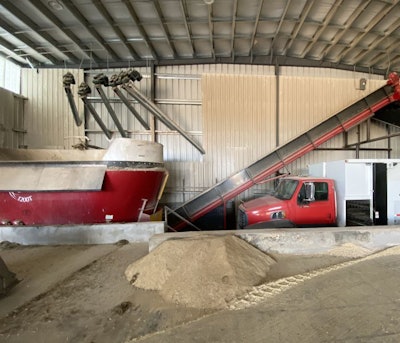 Automation of augers, as pictured above, provides a higher level of accuracy for high-cost and low-inclusion ingredients for rations. This type of system can be used in conjunction with a payloader in the same mixer. (Courtesy Easy Automation)
Automation of augers, as pictured above, provides a higher level of accuracy for high-cost and low-inclusion ingredients for rations. This type of system can be used in conjunction with a payloader in the same mixer. (Courtesy Easy Automation)While feed shrink will never reach zero, reducing the amount of wasted revenue and money back in the farmers’ pocket is the key. Automation technology is an investment that pay for itself in a couple of years if implemented correctly and can lead to enhanced data tracking and traceability, which is the direction in which the industry is moving. Take a step in the right direction and consider an automated feed facility.


